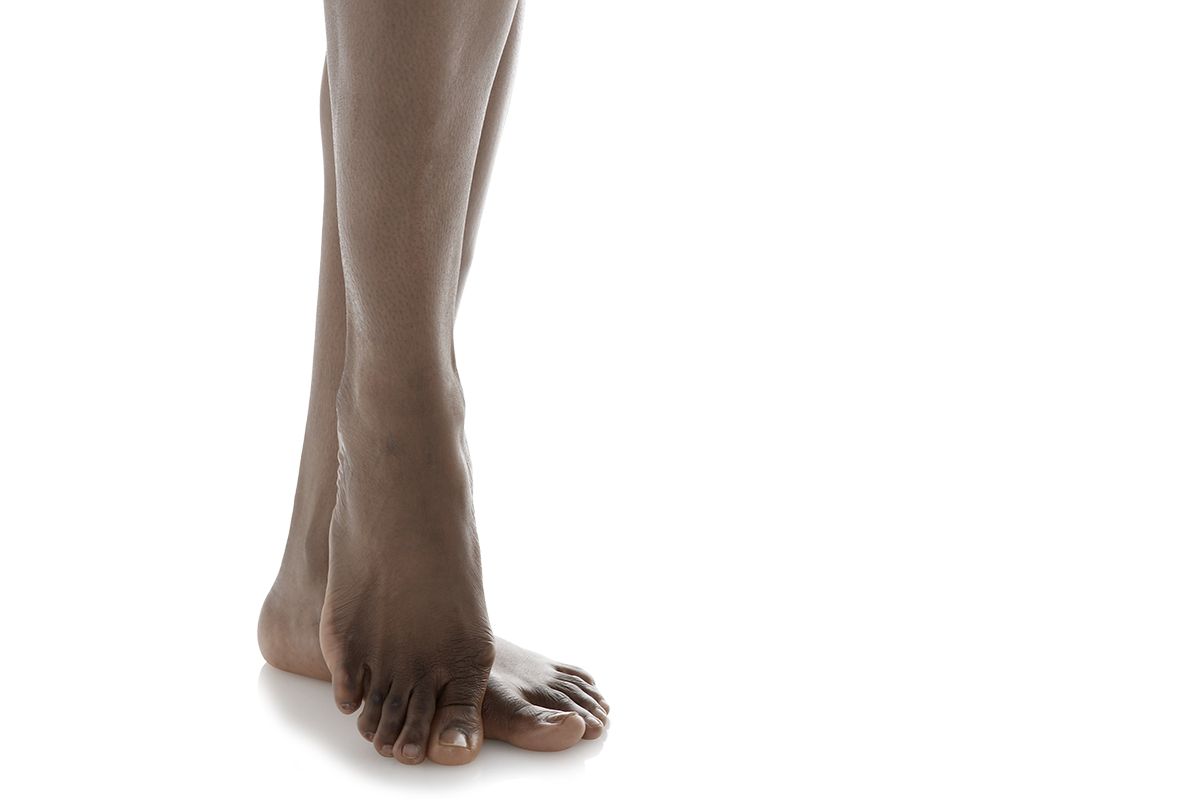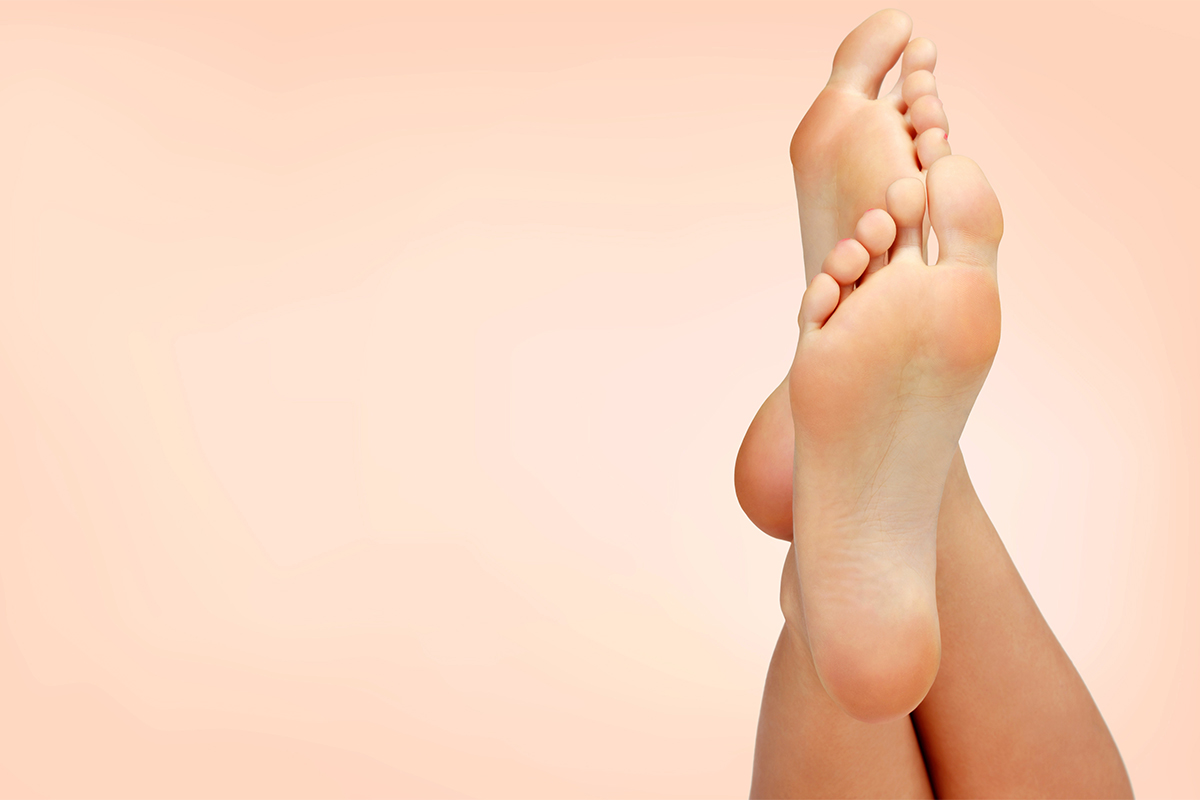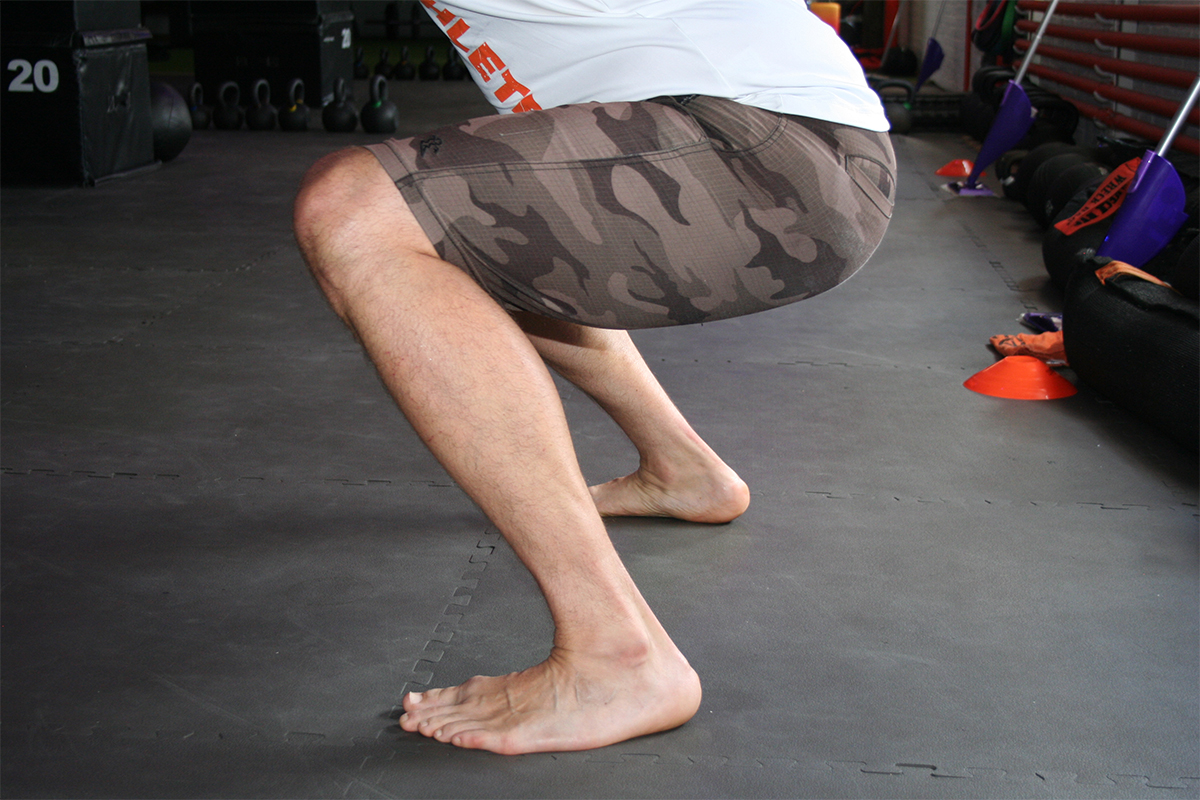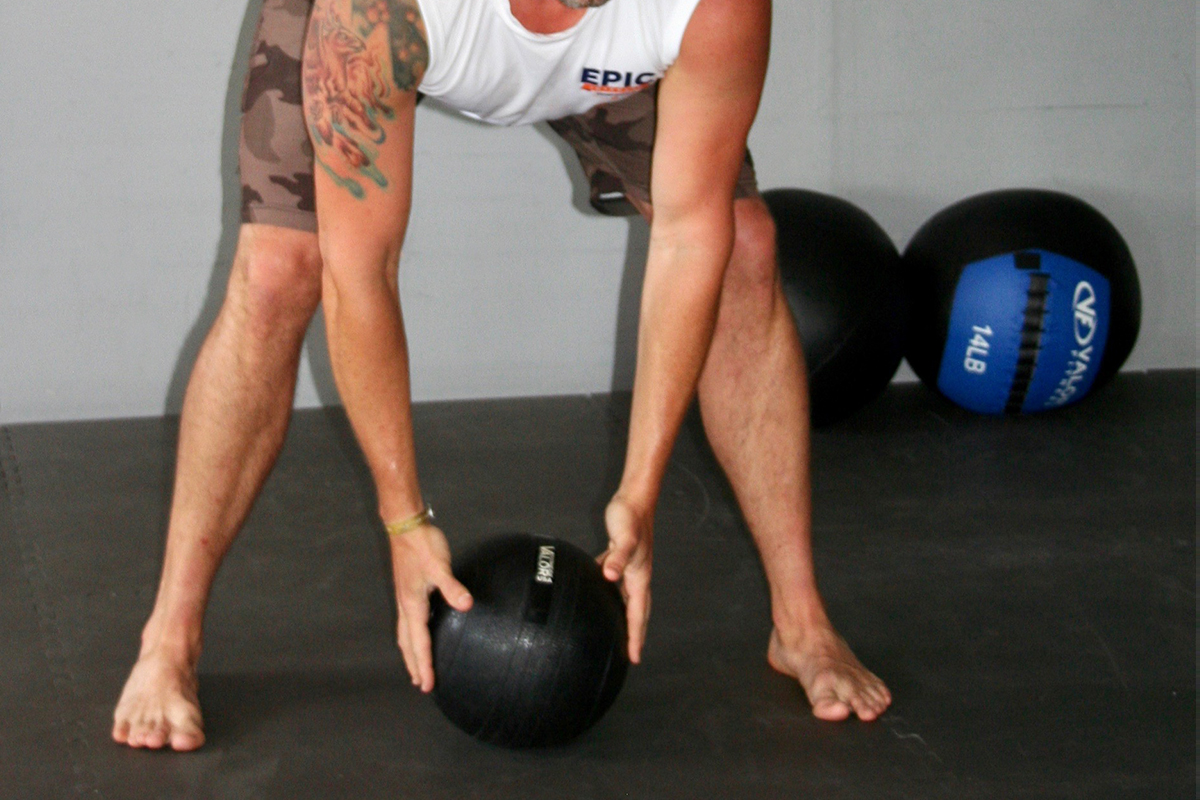Training toward Fleet Feet
Barefoot training offers many benefits that transfer up the kinetic chain.
By Eileen Byrnes
Sep 8, 2020

Many fitness professionals understand how critical healthy, functional feet are to a successful training program. After all, the feet and ankles make up the body’s foundation and act as “shock absorbers” when the body interacts with a surface (Price 2006). Each foot has 26 bones, 33 joints, 19 muscles, 10 tendons and 107 ligaments, with many articulations in each appendage. With this complex structure, the feet transmit weight from our body to the ground, allow us to balance in static posture, and propel our body forward, back and laterally in dynamic activities (Lillis 2019).
While feet are our base for all movement, it isn’t common practice for many athletes, personal trainers, group fitness participants and average gym members to consider foot function. Why not? Perhaps because education is lacking or because of societal pushback against doffing footwear. Nick St. Louis, an Ottawa-based physiotherapist and founder of The Foot Collective, says this needs to change. “A house will collapse if built on a weak foundation. Many of the problems you see upstream are very much related to the foot,” he says, adding that hip, knee and ankle discomfort or pain often starts in foot dysfunction. Being barefoot allows clients to increase balance, engage muscles, improve mobility, transfer stability from one side to the other, and offer efficient force transfer to the ground (Shaffer 2020). “Trainers who advocate barefoot training have a massive opportunity to go deeper with clients,” says St. Louis.
Foot Anatomy
Foot shape, along with the body’s natural balance-keeping systems, makes humans capable of walking, running, climbing and other activities. Foot structure is similar to hand structure, but because the foot bears more weight, it is stronger and less mobile than the hand (McCracken 1999). The foot consists of three parts: the hindfoot (talus and heel bone), the midfoot (the small bones between the heel and toes) and the forefoot (the toes). The hindfoot absorbs shock and displaces it forward and from side to side. The midfoot also helps dissipate force from side to side, and the forefoot further adapts to the ground and pushes the foot off for the next step during walking (Price 2006).
The role of the arch is to help with adaptation as we walk and to absorb shock, decreasing impact on joints (Howell 2010). Although the middle of the foot is often referred to as the arch, there are actually three arches—two longitudinal arches that span from the heel (calcaneus) to the forefoot and one transverse arch. All three are supported and strengthened by ligaments, fasciae and muscles.
The medial arch is the higher of the two longitudinal arches and plays a major role in shock absorption by transferring ground reaction forces to the arch structure to lessen impact on the foot as it hits the ground. This arch is formed by the calcaneus, talus and navicular; three cuneiforms (medial, intermediate and lateral); and the first three metatarsals (Howell 2010).
The lateral arch lies on the ground in the standing position, creating lateral stability, and supports body weight during running and walking. It is formed by the calcaneus, cuboid, and fourth and fifth metatarsals.
The transverse arch spans what is known as the ball of the foot. It is formed by the cuboid, three cuneiforms and the metatarsal bases. It works in conjunction with the other arches to withstand force, absorb shock and prevent excessive spreading of the foot during weight-bearing movement.
While arch movement and stability are controlled by intrinsic and extrinsic muscles, intrinsic muscles are often ignored.
In an article published in 2015 in the British Journal of Sports Medicine, McKeon et al. observe that “interventions for foot-related problems are more often directed at externally supporting the foot rather than training these muscles to function as they are designed.” They also propose that core stability may extend to the foot. “The arch is controlled with both local stabilisers and global movers of the foot, similar to the lumbopelvic core.
“With each footstep, the four layers of intrinsic muscles act to control the degree and velocity of arch deformation. When they are not functioning properly, the foundation becomes unstable and malaligned; and abnormal movement of the foot ensues. This may manifest in foot-related problems.”
The first layer of intrinsic plantar muscles includes the abductor hallucis, flexor digitorum brevis and abductor digiti minimi. These are the most superficial muscles, located immediately beneath the plantar fascia (McKeon et al. 2015). The second layer is made up of the quadratus plantae and lumbricals. The third layer, which comprises the flexor hallucis brevis, adductor hallucis and flexor digiti minimi, plays a role in end toe movement. The fourth layer is between the metatarsals. They are the plantar interossei and dorsal interossei. McKeon et al. conclude that short-foot exercise progressions, which are performed by shortening and raising the medial longitudinal arch, can improve foot function (see “Foot Exercises,” left and below, for examples).
See also: Course: Rescue Your Knees – Look at Your Feet
Foot Fitness From the Field

The benefits of being barefoot in group fitness is a higher-function train-to-transfer probability that translates outside of class.
If you’re not assessing the lower kinetic chain, it’s time to start. The kinetic chain refers to “interrelated groups of body segments, connecting joints, and muscles working together to perform movements and the portion of the spine to which they connect” (Sanchez 2019). The lower kinetic chain includes the toes, feet, ankles, legs, hips, pelvis and spine.
St. Louis recommends that clients be evaluated early in the assessment phase. He suggests using a barefoot, one-legged stance, which provides a lot of information and will tell a trainer how much or how little proprioception the client has. “It gives you a pure idea of where someone is in space,” St. Louis says. “If you can’t stand on one leg, how are you going to jump? It lets you know if you are overshooting someone’s capacity.”
Matthew Sonak, owner and coach at EPIC Interval Training Fairfield County in Bridgeport, Connecticut, agrees. He says being barefoot allows clients to maintain proper biomechanics, working the force of the movement into muscles, rather than joints and tendons. “Shoes are a crutch,” Sonak explains. “You don’t get that natural movement. The body is designed perfectly, and we are messing it up.”
Sonak says some people are apprehensive about taking their shoes off for his initial small-group session, but once they experience a class, going barefoot becomes second nature. He admits that being barefoot deters some people from training with him but says his classes are generally well-attended.
Courtney Conley, DC, from GAIT Happens in Golden, Colorado, says an increase in personal trainers attending her courses and workshops makes her optimistic and hopeful that more fitness professionals are paying attention to the importance of foot function in proximal stability. “When you’re training clients, their foot is the foundation for everything that sits above it,” she says. “When the foot gets weak, it can no longer do its job, so something up the chain will have to.”
Athletic shoes will be ditched in group fitness classes only when fitness educators lead the way, says Stacey Lei Krauss, creator of Cardio Yoga™ and The willPower Method®—both barefoot movement experiences. “The barefoot movement must be encouraged by industry leadership for it to stick. Students trust their teachers,” she says. “When smart, forward-thinking fitness influencers explain how and why we should be using our feet, then foot fitness will become an industry norm instead of specialized training. Everyone should be using their feet. This is not fringe thinking.”
One fitness industry influencer promoting natural foot movement is Lawrence Biscontini, MA, 2004 IDEA Fitness Instructor of the Year. During a 2-day international summit online, Biscontini conducted programs barefoot or in minimalist shoes to encourage more recruitment and use of foot muscles. He noted that even those giving lectures were shoeless. Biscontini says the benefits of being barefoot in group fitness is a higher-function train-to-transfer probability that translates outside of class to gait efficiency and recovery, less propensity to fall, more overall foot health, and an increased sense of stability—unless conditions such as neuropathy are present.
See also: Fit Feet: The Professional’s Guide to Training South of the Ankles
Barely Barefoot
Despite advocates working to spread the word about the importance of toe spreading and natural foot movement, most gyms require shoes to be worn at all times, citing sanitary reasons and potentially dangerous contact with equipment. St. Louis, however, counters that feet pose less of a risk for spreading germs than shoes do. Sonak believes his boutique studio is cleaner than many gyms because clients leave “outside elements” on shoes at the door.
As virtual classes grow, says Krauss, the concern about working out on a dirty public floor is removed. “Now we aren’t up against that problem,” she said. “[Participants] ought to be barefoot.” Conley says once she began to understand the importance of foot function and proximal stability, the decision to go barefoot was easy. “Do you want to be on a tripod or ice skates?” she asks. “Feet,” she says, “deserve respect.”
References
Gooding, T.M., et al. 2016. Intrinsic foot muscle activation during specific exercises: A T2 time magnetic resonance imaging study. Journal of Athletic Training, 51 (8), 644–50.
Howell, D.L. 2010. The Barefoot Book: 50 Great Reasons to Kick Off Your Shoes. Alameda, CA: Hunter House Publishers.
Lillis, C. 2019. Foot bones: Everything you need to know. Medical News Today. Accessed June 4, 2020: medicalnewstoday.com/articles/324336.
McCracken, T.O. 1999. New Atlas of Human Anatomy. New York: Barnes & Noble Books.
McKeon, P.O., et al. 2015. The foot core system: A new paradigm for understanding intrinsic foot muscle function. British Journal of Sports Medicine, 49 (290).
Price, J. 2006. The foot, ankle and knee. IDEA Fitness Journal, 3 (10), 30–33.
Sanchez, D. 2019. What is the kinetic chain? Accessed June 9, 2020: acefitness.org/fitness-certifications/ace-answers/exam-preparation-blog/2929/what-is-the-kinetic-chain/.
Shaffer, A. 2020. Everything you need to know about barefoot training. Muscle & Fitness. Accessed June 2, 2020: muscleandfitness.com/muscle-fitness-hers/hers features/everything-you-need-know-about-barefoot-training/.Fitness Journal - September-October 2020
Foot Exercises
There are many ways to incorporate foot exercises in one-on-one training. Be sure the client knows the difference between discomfort and pain. Inactive foot muscles may fatigue quickly, but daily exercise will build strength and endurance. Stacey Lei Krauss, creator of Cardio Yoga™and The willPower Method®, notes that walking barefoot and paying attention to “exercising” the feet in different ways improve foot endurance, strength and flexibility. She adds that warming up the feet before movement is as important as moving the spine in three planes of motion. “It’s just like what you do to the rest of your body; you’re just focusing on your feet,” she says.
Try the following as part of a warmup or during the stretch phase of a workout. Or, give these moves to clients as “homework.”
Short-Foot Exercises
Perform short-foot moves by shortening and raising the medial longitudinal arch. Bring the metatarsal heads (ball of the foot) toward the calcaneus (heel) without flexing the toes or contracting the extrinsic foot muscles.
- Stand on a stable surface barefoot.
- Draw the metatarsal heads toward the calcaneus, being careful to keep the toes long and avoid contracting extrinsic foot muscles.
- Raise the transverse arch slightly off the floor.
- Do each of the above several times
until your foot muscles fatigue.
Toe Spreading
- Stand on a stable surface.
- Extend and simultaneously abduct the toes.
- Create as much space between digits as possible.
- Repeat several times, each foot.
Marble Pick Up
- Put a pile of marbles on the floor.
- Instruct the client to pick up each marble with the toes, creating a second pile.
- Repeat several times, each foot.
Toe Yoga
- Extend the hallux (big toe) while toes 2–5 stay on the floor.
- Alternate, lifting and lowering toes 2–5 and then the hallux.
- Do each foot separately and then both feet together.
Note that when clients are hyperfocusing on a foot exercise, they may sometimes breathe shallowly.
Beginning and End
- Extend all your toes.
- Alternate pressing the hallux and fifth toe to the floor, keeping the ankle centered.
- Extend all toes and simultaneously press the hallux and fifth toe to the floor, keeping the middle toes lifted.
- Repeat, each foot.
Band Work
- Fasten a resistance band to a secure point, placing the other end of the band on the top or dorsal side of the foot, below the toes.
- Dorsiflex the foot and relax.
- Repeat several times, each foot.
Ball Rolling
Ball rolling can be performed while sitting or standing. You can recommend that clients do these exercises daily or even multiple times a day.
- Roll a lacrosse ball or tennis ball under the middle of your foot and roll horizontally and vertically between the ball of your foot and the calcaneus.
- Apply more pressure when rolling from the transverse arch to the calcaneus. This takes slack out of the fascia, rather than increasing it.
- Roll along the lateral arch and then the medial.
- Roll from your calcaneus to the toes, making a path to the tip of each toe. Use lighter pressure when rolling over the sesamoid bones, which are two pea-shaped bones embedded in the tendon of the flexor hallucis brevis, just under the base of the hallux.
Foot Stretch
This is a good stretch for plantar foot muscles and the plantar fascia ligament.
- Kneel and tuck all toes under the buttocks.
- Press the toe pads into the floor. Place a blanket or cushion under the knees if the client feels discomfort.
- Spend 20–30 seconds in this position and gradually work toward 1 minute.
Napkin Folding
- Spread a napkin on the floor.
- Instruct the client to grip one corner with the toes and fold the napkin in half.
- Fold again in quarters.
- Repeat, both feet.
Incorporating Barefoot Training

Take a gradual approach, adding barefoot training to sessions one segment at a time. As a client becomes more comfortable with being barefoot and as proximal stability increases, add more segments. Try incorporating the following into your program design:
- Pushups: In a barefoot pushup position, deeply flex the toes. This helps with foot mobility and increases range of motion.
- Squats: Without shoes, discover how you can drive more into your heels, creating a deep squat.
- Lunges: For stability, grip more with your entire foot than you would when wearing shoes. Start with no weights and slowly progress, adding load as tolerable.
- Dumbbells in tandem feet: Place one foot behind the other, either with a few inches between the feet or with back toes touching the front heel. Switch foot position for the next set. Being barefoot requires more balance and stabilization and allows for upper-body and balance work at the same time.
- Note: The stretch phase at the end of a session is a great time to introduce a client to going barefoot.
- For clients who are apprehensive about going barefoot, suggest a yoga, tai chi, Pilates or barre class. Most of these formats are done barefoot.
Foot Fitness and Function

When bare feet connect to the ground or floor, the skin contains an extensive network
of nerve endings and touch receptors, making them sensitive to stimuli (Howell 2010). Once the receptors are activated, a series of nerve impulses is triggered and transmitted to the brain. This feedback is critical in proprioception and kinesthetic awareness.
In addition to the plantar sensors, nerves such as the sural, saphenous, medial and lateral plantar, and plantar digital nerves and the calcaneal branches of the tibial and sural nerves deliver messages to the brain about the position of joints, the length and tension of muscles, and movement so that balance can be maintained (Howell 2010). The medial and plantar nerves are the largest nerves at the bottom of the foot.
Gooding et al. (2016) concluded that toe spreading, hallux extension and second-fifth-toe extension exercises activate and strengthen the intrinsic plantar foot muscles. McKeon et al. (2015) found that sensory input is important in postural stability and dynamic gait patterns. They noted that in a study of single-leg standing, postural stability significantly improved in participants who stood barefoot rather than in socks, because socks filter out sensory input that assists with static stability.
“In fact, stability progressively increased with decreasing amount of footwear support,” the authors wrote. “These studies highlight the potential importance of sensory input to the function of the foot. Therefore barefoot activities, in safe environments, should assist in improving foot function.”
In conclusion, McKeon et al. stated that “clearly a stronger foot is a healthier foot.” However, the study noted that those without plantar sensation should avoid barefoot activities.
https://www.ideafit.com/personal-training/training-toward-fleet-feet/

